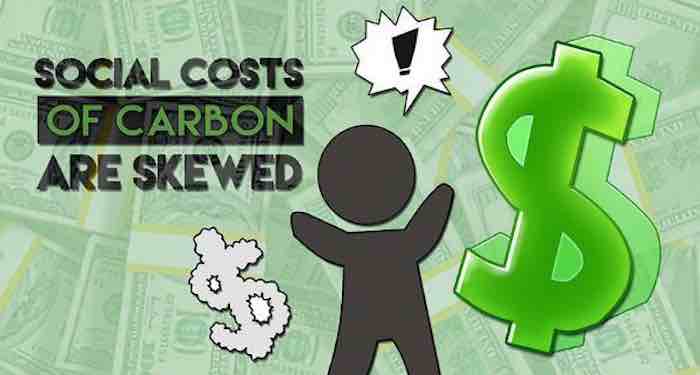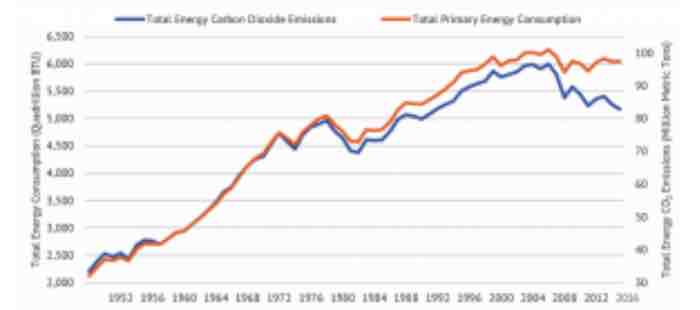By Institute for Energy Research ——Bio and Archives--March 29, 2018
Global Warming-Energy-Environment | CFP Comments | Reader Friendly | Subscribe | Email Us
 Earlier this month, Reason Foundation's Julian Morris released an excellent policy study examining climate change, regulation, and the social cost of carbon (SCC). In the study, Morris highlights six problems with calculating the social cost of carbon. In this blog, I'll provided an outline of those six problems, as well as some additional information on the work IER's staff has done on the social cost of carbon. I strongly encourage you to read the entire policy study, as it provides a great overview of the problems many have identified with calculating the social cost of carbon.
Earlier this month, Reason Foundation's Julian Morris released an excellent policy study examining climate change, regulation, and the social cost of carbon (SCC). In the study, Morris highlights six problems with calculating the social cost of carbon. In this blog, I'll provided an outline of those six problems, as well as some additional information on the work IER's staff has done on the social cost of carbon. I strongly encourage you to read the entire policy study, as it provides a great overview of the problems many have identified with calculating the social cost of carbon.Future human-related emissions of GHGs will depend on many factors, especially: the human population, the extent and use of technologies that result in energy consumption, the types of technology used to produce energy, and the efficiency with which technologies use energy.Policymakers have routinely failed in their ability to predict future technological change in the energy industry--the most recent example being their inability to foresee the tremendous changes brought about by the shale revolution. These technological changes have caused an increase in the use of more energy-dense fuels like natural gas. Consequently, greenhouse gas emissions from U.S. sources have declined from their recent peak.
 Source: Energy Information Administration. March 2017 Monthly Energy Review
Source: Energy Information Administration. March 2017 Monthly Energy Review
The rate at which GHGs such as methane and dinitrogen monoxide break down depends on such things as temperature and the amount of water vapor and other chemicals in the atmosphere with which they might react. The rate at which CO2 is taken up by plants, soil and oceans varies considerably depending on factors such as temperature and the availability of nutrients. The dynamic and interactive nature of these effects complicates the picture further.3. It's likely the sensitivity of climate to increased concentrations of greenhouse gases is much less than many of the earlier models predicted. Morris writes:
Early estimates of the sensitivity of the climate to increased concentrations of greenhouse gases found that a doubling of atmospheric carbon dioxide would result in a warming of between 1.5°C and 4.5°C, with a "best guess" of 3°C. But those estimates were based on poorly specified models. Tests of models using those estimates of climate sensitivity predict about twice as much warming as actually occurred. Nonetheless, the IWG used those early, inaccurate estimates. More recent estimates of climate sensitivity suggest that future emissions are likely to result in much more modest warming of the atmosphere (with a doubling of carbon dioxide concentrations resulting in a warming of 1.5°C or less).4. It's possible the benefits of climate change outweigh the costs, at least for likely ranges of change. Some of the benefits of climate change may include better agricultural output caused by increased concentrations of carbon dioxide in the atmosphere and a lower number of deaths caused by cold temperatures. Furthermore, Morris points out that many economic models assume very limited adaptation, meaning it is likely they are overestimating negative impacts of climate change. He explains:
Rising wealth and the adoption of new technologies have reduced mortality from extreme weather events by 98% in the past century (see Figure ES4). It seems highly likely that continued innovation and more widespread adoption of adaptive technologies will continue to reduce mortality, mitigating most--if not all--[of] the adverse consequences of rising temperatures.
Support Canada Free Press

Proponents of taking action now argue that any delay would increase the total cost of emissions reductions--because baseline emissions (i.e. the emissions that would occur without any mandated reductions) would be higher and the size of any such future reduction would have to be greater. But such arguments presume both significant increases in baseline emissions and a need dramatically to reduce such emissions. If the trends in technology identified earlier do continue, growth in baseline GHG emissions will continue to slow and in the longer term may even fall without any government mandates. Indeed, it is possible that baseline emissions in the future (i.e. after 2050) will be consistent with a pathway of emissions that results in atmospheric GHG concentrations that generate net benefits.6. The Interagency Working Group (IWG) used inappropriately low discount rates when assessing costs and benefits. When discount rates that accurately reflect the opportunity cost of capital are used, the costs of taking action to reduce future GHG emissions now is likely greater than the benefits of taking such action. He explains:
Unfortunately, when discounting the benefits and costs associated with global warming, many analysts have used discount rates that do not reflect the opportunity cost of capital. For example, the IWG provided an estimate of the SCC at a 5% discount rate, but it is the highest rate given. In its guidance, the IWG emphasized the SCC calculated at a 3% discount rate. Its rationale for using the lower rate is that future benefits from avoiding climate change costs relate to future consumption, rather than investment. Policies to address climate change would affect both consumption and investment, but for the purposes of evaluation what matters is the effect on investment, since it is the effect of policies on investment decisions that will determine rates of innovation and hence economic growth, the ability to adapt to climate change, and future consumption. In other words, while future consumption is of primary concern, due to its relationship to human welfare, return on investment is the key factor determining future consumption. Thus, the appropriate discount rate is the rate of return on capital.It's not simply that Morris thinks a 7 percent discount rate is more appropriate. In 2014, IER's Robert Murphy pointed out that the Obama administration's IWG ignored OMB guidelines to provide a SCC estimate based on both a 3 and 7 percent discount rate. Instead, they reported their estimates based on a global perspective, and the highest discount rate they used was 5 percent. Here, Murphy explains why the choice of discount rate is an important element when calculating the SCC:
To see what a big deal this is, consider the Heritage Foundation's analysis of the FUND model, one of the three used by the Working Group to generate its SCC estimates. The table below shows the FUND model's estimates of the SCC at various discount rates, including the 7% rate that the OMB requires but that the Working Group for some reason ignored:It's clear that the social cost of carbon is a misleading tool for policymaking as it is presented as an objective fact. However, as Julian Morris's policy study helps demonstrate, many of the parameters for calculating the SCC are impossible to measure, while others can be adjusted up or down based on any number of assumptions. This is why we at IER have continued to argue that the SCC is not an appropriate tool for policymaking. The post Julian Morris Outlines Problems with the Social Cost of Carbon appeared first on IER.As the above table shows, at a 7% discount rate the FUND model actually shows a negative SCC through at least the year 2030. For those keeping score at home, a "negative social cost of carbon" is the same thing as a positive social benefit of carbon.
View Comments
The Institute for Energy Research (IER) is a not-for-profit organization that conducts intensive research and analysis on the functions, operations, and government regulation of global energy markets. IER maintains that freely-functioning energy markets provide the most efficient and effective solutions to today’s global energy and environmental challenges and, as such, are critical to the well-being of individuals and society.